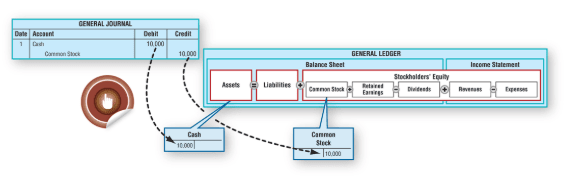
Profits made by a company that are not paid out as dividends to stockholders (shareholders) but rather are set aside for reinvestment in the company are known as retained earnings (RE). Working capital, the purchase of fixed assets, or debt repayment are just a few uses for retained earnings. This means the stockholders’ equity of the company is $300,000 when calculated directly from total assets and total liabilities.
The Financial Modeling Certification
Companies have no obligation whatsoever to pay out dividends until they have been formally declared by the board. There are four key dates in terms of dividend payments, two of which require balance sheet specific accounting treatments in terms of journal entries. There are various kinds of dividends that companies may compensate its shareholders, of which cash and stock are the most prevalent. Retained Earnings (RE) are business’ profits that are not distributed as dividends to stockholders (shareholders) but instead are allocated for investment back into the business. Retained Earnings can be used for funding working capital, fixed asset purchases, or debt servicing, among other things.
How to Calculate the Equity Ratio
If used in conjunction with other tools and metrics, an investor can accurately analyze the health of an organization. When liquidation occurs, there’s a pecking order that applies which dictates who gets paid out first. Calculating stockholders’ equity can give investors a better idea of what assets might be left (and paid out to shareholders) once all outstanding liabilities or debts are satisfied.

Shareholders’ Equity
Financial professionals use different ratios to check how well a company performs. Shareholders‘ equity plays a crucial role in this and helps them decide Accounting Security whether to invest in a company by assessing its financial strength. For someone who is considering investing in a company, knowing about shareholders‘ equity can help to better understand its financial health. The book value of equity is essentially the same as SE, representing the net worth of the company attributable to the company’s shareholders after deducting liabilities from assets. An accumulated deficit, also known as a retained earnings deficit or accumulated loss, occurs when a company’s cumulative losses and dividend payments exceed its cumulative profits. Additional paid-in capital (APIC) is the amount of money investors pay for a company’s stock above its par value.
The total stockholders‘ equity for a given period represents the total at the end of the period. To find the beginning stockholders‘ equity for that period, look at the balance sheet for the preceding period. If a company theoretically sells all of its assets at book value and uses the proceeds to pay off all its liabilities, the money left over would represent the company’s stockholders‘ equity. These may include loans, accounts payable, mortgages, deferred revenues, bond issues, warranties, and accrued expenses. Liabilities are debts that a company owes and costs that it must pay to keep running. Debt is a liability whether it’s a long-term loan or a bill that’s due to be paid.

In other words, if ABC Widgets liquidated all of its assets to pay off its debt, the shareholders would retain 75% of the company’s financial resources. It will result in an increase in the company’s inventory which is an asset while reducing cash capital which is another asset if a business buys raw materials and pays in cash. Two or more accounts are affected by every transaction carried out by a company so the accounting system is referred to as double-entry accounting. At some point, the amount of accumulated retained earnings can exceed the amount of equity capital contributed by stockholders. Retained earnings are usually the largest component of stockholders‘ equity for companies operating for many years.

Privately held companies can then seek investors by selling off shares directly in private placements. These private equity investors can include institutions like pension funds, university endowments, insurance companies, or accredited individuals. In the stock market, shareholders‘ equity (or owners‘ equity for privately held companies), represents the difference between a company’s assets and liabilities. If all of the company’s assets were liquidated and used to pay off debts, the shareholder’s equity is the amount that would be left over.
- All these benefits eventually create a shareholder’s ongoing interest in the company’s equity.
- From the viewpoint of shareholders, treasury stock is a discretionary decision made by management to indirectly compensate equity holders.
- Now let’s talk about shareholders equity, often known as shareholder’s capital or net assets.
- After all, the only way to know exactly what a building is worth is to sell it.
- It’s possible for retained earnings to represent the largest share of owner equity if growth substantially outpaces the amount of capital paid in.
What Does the Shareholder Equity Ratio Tell You?
- Cyclical industries tend to generate higher ROEs than defensive industries, which is due to the different risk characteristics attributable to them.
- These may include loans, accounts payable, mortgages, deferred revenues, bond issues, warranties, and accrued expenses.
- In many cases, paid-in capital is not broken out on the balance sheet into two separate line items for the par value and the capital in excess of par value.
- A firm typically can raise capital by issuing debt (in the form of a loan or via bonds) or equity (by selling stock).
- The relationship between SE and dividends is that when a company pays out cash dividends, it reduces its SE by decreasing retained earnings, which is a component of equity.
Creating and using statements of SE is essential for providing a transparent and detailed account of changes in equity over a reporting period. In order to satisfy investors, a company should be able to generate a higher how to find stockholders equity ROE than the return available from a lower risk investment. Intangible assets such as goodwill are normally excluded from the ratio, as reflected in the formula. Below is a break down of subject weightings in the FMVA® financial analyst program. As you can see there is a heavy focus on financial modeling, finance, Excel, business valuation, budgeting/forecasting, PowerPoint presentations, accounting and business strategy.
How to Calculate Stockholders’ Equity
- With this information, we can work our way backward to figure out beginning stockholders‘ equity.
- All three metrics are readily found on the balance sheet of any publicly traded company.
- Talking to a financial advisor can help you develop a strategy for investing that fits your goals.
- Therefore, the stockholder’s equity of Apple Inc. has declined from $134,047 Mn as at September 30, 2017 to $107,147 Mn as at September 29, 2018.
- Common share capital or common stock capital is typically listed as a line item in the share capital account.
The relationship between SE and dividends is that when a company pays out cash dividends, it reduces its SE by decreasing retained earnings, which is a component of equity. Note, however, that share buybacks reduce the company’s cash reserves because the company taps its own cash reserves or takes on debt to repurchase its shares. So, this reduction in assets can decrease the overall SE on the balance sheet. The number of preferred shares is usually disclosed in the company’s financial statements under the equity section. If it’s not directly available, you might find it in the notes of the financial statements. Long-term liabilities, also known as non-current liabilities, are financial obligations that are due beyond one year or the normal operating cycle of the company.